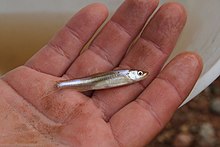Biology
This freshwater fish inhabits medium and large rivers, channels, and pools. It can be found in shallow, turbid waters over sand and mud substrates. [1]
The fish feeds on aquatic and terrestrial invertebrates, including flies, caddisflies, bugs, beetles, odonates, and ostracods. It consumes large amounts of sand and sediment, suggesting that it forages on the riverbed. It may also consume some plant material. [5]
Its life history is not well documented. [2]
Conservation
Several threats have contributed to the decline of the species.
Inflow from reservoirs has altered the physical and biological characteristics of the river system, such as temperature, flow patterns, and turbidity, and have contributed to habitat fragmentation and other changes to the ecosystem. The Possum Kingdom, Granbury, and Whitney Reservoirs have produced changes in the aquatic faunal communities of the Brazos River. [2] The construction of more reservoirs is expected to prevent the fish from recolonizing habitat where it is now absent. [2]
The invasive plant salt cedar (Tamarix spp.) has become abundant along the Brazos River, its spread aided by the construction of reservoirs. The plant likely increases sedimentation and alters water flow, making parts of the habitat unsuitable for the fish. [2]
The Brazos River is a relatively saline river because of the salts in the surrounding land and a salty aquifer beneath, and the fish is adapted to the saline waters. There is increasing interest in desalination of the river water for municipal use. Planned desalination projects include the construction of wells, pipelines, evaporation ponds, and reservoirs for water treatment. These projects, as well as ongoing wastewater and agricultural runoff, are expected to alter water and habitat quality. [2] Gravel and sand mining have produced significant effects on the lower Brazos, but their specific impacts on the fish are not clear. [2] Algal blooms may also affect the species, but evidence is not yet available. [1]
This page is based on this
Wikipedia article Text is available under the
CC BY-SA 4.0 license; additional terms may apply.
Images, videos and audio are available under their respective licenses.

